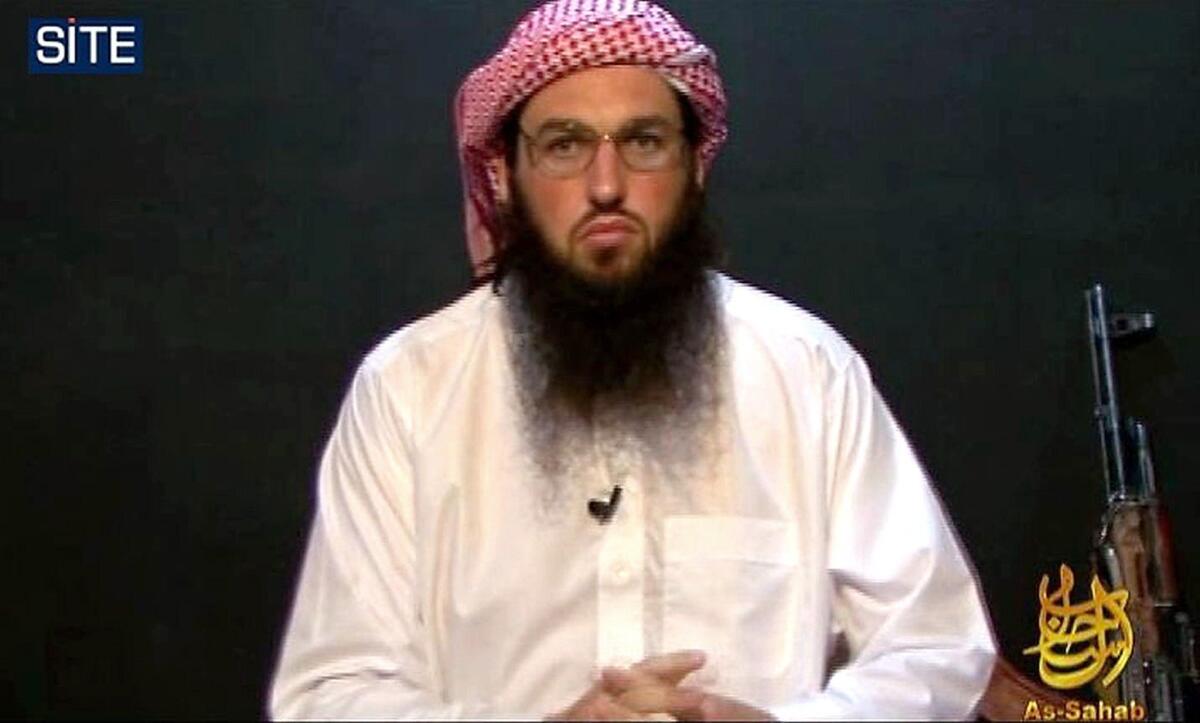SoCal native âAzzam the Americanâ: from convert to Al Qaeda spokesman

The videos started in 2004. The speaker on the tape wore a head scarf that covered everything but his eyes. He identified himself as âAzzam the Americanâ and spoke for an hour, warning of the impending violence that would wash U.S. streets with blood.
Almost a year later, he emerged again, listing Los Angeles and Melbourne as new targets for terrorist attacks. âDonât count on us demonstrating restraint or compassion,â he said.
Initially only his voice was recognizable, but by the time he made his third video in 2006, he had dropped his disguise. Azzam the American â or Azzam al-Amriki â was Adam Yahiye Gadahn, a Southern California native who had stepped onto the world stage as a spokesman for Al Qaeda.
The White House confirmed Thursday that Gadahn was killed in a U.S. operation in Pakistan in January.
His death marks the end of a 20-year odyssey that began with a mosque in Garden Grove and ended with the unanswerable questions of how and why a young American, a convert to Islam, could be swept up in a tide of extremism.
Gadahn was a homegrown, the term used for Westerners who prove themselves willing to attack their own societies. After his first video was released, he was compared to John Walker Lindh, the Marin County man sentenced to 20 years in prison for fighting with the Taliban in Afghanistan.
But unlike Lindh, Gadahn ascended into Al Qaedaâs inner circle, meeting with Osama bin Laden and self-proclaimed Sept. 11 mastermind Khalid Shaikh Mohammed. Two of the videos in which he appeared also featured Al Qaedaâs No. 2 leader, Ayman Zawahiri.
Known for numerous aliases, including Abu Suhayb Al-Amriki, Abu Suhayb, Yihya Majadin Adams and Adam Pearlman, Gadahn had dropped out of American society in the late 1990s. He traveled to Pakistan, attended training camps in Afghanistan and aligned himself with senior Al Qaeda officials.
He initially worked as a translator but grew to become a critical propagandist, valued for his ability to speak to the American people in a familiar idiom.
He had been on the FBIâs list of most wanted terrorists and was the first American since the World War II era to be charged with treason. The U.S. government had offered a $1-million reward for information leading to his arrest.
Gadahn was the grandson of a Jewish urologist, Carl K. Pearlman, who was well-known in the philanthropic circles of Orange County. Pearlman worked with various charities to aid Jews after World War II and was a member of the Anti-Defamation League and the Orange County Philharmonic Society.
Perlmanâs son, Philip, dropped out of UC Irvine in the 1960s, developed a passion for psychedelic guitar and moved to Oregon. After a religious conversion, he changed his surname to Gadahn and moved to a 40-acre goat ranch in Winchester in Riverside County in the 1970s.
His mother was raised Catholic, and Gadahn was home-schooled. He played Little League. Those who remembered him called him a loner. At 16, he left his familyâs home and moved in with his grandparents in Santa Ana.
Writing on a website years later, he described turning from death metal to Christian radio for spiritual answers in an attempt to fill a âvoid I had created from myself.â Disenchanted with Christianity, he began visiting Islamic websites and Internet discussion groups.
His spiritual journey took him to the Islamic Society of Orange County, where he met two radical Muslims, Khalil Deek and Hisham Diab, who lived near Little Gaza, a stretch of Arab-owned shops on Brookhurst Street in Anaheim.The two men had hosted Omar Abdel-Rahman in California before his arrest and conviction for the 1993 bombing of the World Trade Center.
âDeek and Diab met [Gadahn] at the mosque, and [Diab] brought him home like a lost dog,â Saraah Olson, Diabâs ex-wife, told The Times in 2006. âHe was hungry, and [Diab] asked me to give him something to eat. Then they begin teaching the kid their version of Islam.â
In 1995, Gadahn converted to Islam. His aunt, Nancy Pearlman, described him in 2004 as a âsweet, loving individualâ who wasnât fanatical about his adopted religion. Pearlman, a Los Angeles Community College District trustee, declined to comment on his death.
By 1996, Gadahn lived with a handful of other Muslims near the mosque.
He worked as a security guard at the Islamic Society but was fired for sleeping on the job, an incident that eventually led him to assault one of the Societyâs leaders. He pleaded guilty and disappeared soon after sentencing.
By the time the 2004 video appeared, few could believe that Gadahn could play a key role in Al Qaeda.
âIt was not as if he was on the radar screen as the top 10 terrorist or anything like that,â one counter-terrorism official told The Times.
Muzammil Siddiqi, religious director at the Islamic Society of Orange County, remembers Gadahn as a quiet young man who didnât want to talk about Islam and needed help finding a job.
âItâs very sad that somebody would follow that path,â Siddiqi said.
Times staff writers Veronica Rocha and Emily Foxhall contributed to this story.
More to Read
Sign up for Essential California
The most important California stories and recommendations in your inbox every morning.
You may occasionally receive promotional content from the Los Angeles Times.











